We continue to hold a consistent view—SOL through ETF is not a yes or no, but rather When.
This research will be divided into several parts:
(1) Was the recent collapse of Solana an end or a new beginning?
(2) The New Chain War is beginning.
(3) The subsequent guidance of the primary market.
01. Was the recent collapse of Solana an end or a new beginning?
1.1 Value Targets on Solana
It is only a matter of time before SOL is available through ETF, specifically around May to June.
With Trump issuing coins on Solana, the circulating market value once reached 14 billion USD, and Solana/TRUMP began to gradually break into the mainstream. It is likely that as Trump approaches ATH, friends outside the circle may start asking how to purchase Trump and Solana. On that day, Moonshot, as a very web2 user-friendly crypto brokerage, achieved a historical ATH in revenue, with a single-day income of 6.3 million USD.
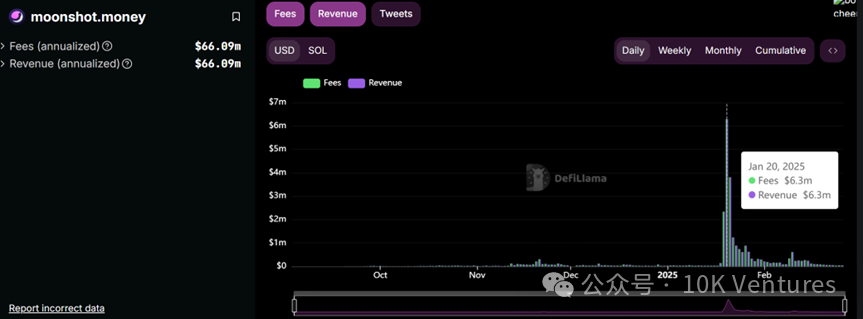
As Trump/Solana gradually breaks into the retail level, the launch of the SOL ETF is also in full swing. As of February 27, 2025, the latest progress of the SOL ETF is that it has been listed on DTCC (just as I was writing this article, news reported that the SOL ETF was listed on DTCC). DTCC (Depository Trust & Clearing Corporation) is the largest financial transaction backend service organization in the United States, responsible for the centralized custody and settlement of securities such as stocks and bonds, providing settlement and custody services for major exchanges including NYSE and Nasdaq. When a commodity or security is listed on DTCC, it means it is included in the DTCC's centralized custody and settlement system. This does not directly represent that the commodity or security will definitely be listed on Nasdaq.
However, it is worth noting that the first BTC ETF was listed on DTCC on October 23, 2023, and the subsequent BTC ETF went live on Nasdaq on January 11, 2024 (two and a half months later); the first ETH ETF was listed on DTCC on April 26, 2024, and the subsequent ETH ETF went live on Nasdaq on July 23, 2024 (three months later).
Therefore, we continue to hold our consistent view—SOL through ETF is not a yes or no, but rather When. The timing should be in 2-3 months, around mid-May to June.
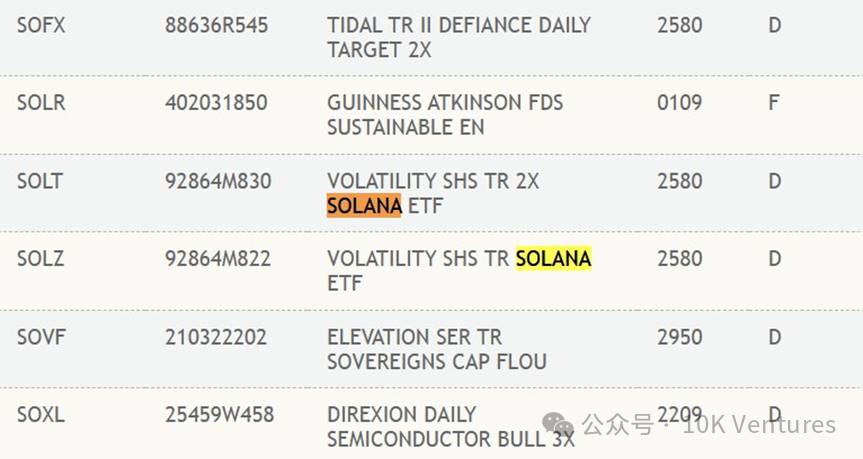
Pump.fun remains one of the best cash flow decentralized companies in the crypto space.
Pump.fun was born in early 2024, began to have a certain trading volume in mid-2024, and exploded after October 2024. Pump.fun is a one-stop meme coin launch platform. After users create tokens, they only need to pay a fee of 0.02 SOL to mint the tokens and immediately add them to the Pump.fun market. Pump.fun uses a bonding curve to define prices. The more tokens users buy, the price will rise along a predefined curve. 100% of the tokens are sold through the curve, ensuring there is no unfair advantage. This model eliminates the need for creators to provide initial liquidity, reducing financial barriers. Meme coins on Pump.fun can be traded within the platform, and users can buy and sell tokens at any time based on the joint curve model. Once the market value of a token reaches 100k, the token automatically migrates to Raydium (but it has now been found that Pump.fun has deployed its own liquidity pool, starting to capture the Raydium market). The liquidity is then deposited into Raydium, and 17% of the liquidity tokens are burned.
As of February 27, 2025, priced at $140/SOL, this amounts to approximately $574 million in first-year revenue, making it one of the most successful products in the crypto industry.

Before 2021, the growth path of VC coins typically involved finding VC funding, launching on the mainnet while issuing coins on exchanges, and gradually starting business after having the coins. After 2021, the model changed to financing while developing, then issuing airdrops, going to exchanges, and continuing business. The problem arose after the collapse of FTX, where only Binance remained dominant, leading to a complete loss of bargaining power for project parties regarding coin listings, as not being listed on Binance meant no best liquidity. Project parties had to give a large number of tokens to Binance/BNB holders. This resulted in significant sell-offs for projects listed on Binance in the early stages, coming from airdrops/project parties/market makers, making it impossible for retail investors to make money in the secondary market. To address this issue, project parties had to continuously raise valuations in the primary market, allowing them to give only 2%-5% of tokens to Binance.
In the past, what attracted retail investors to the crypto market was the secondary wealth creation effect; in 2021, anything bought on Binance could earn money, and VC coins could multiply in value. However, as valuations in the primary market became too high, retail investors could not earn the profits they desired in the secondary market, leading them to completely withdraw (of course, shorting overvalued assets could also be profitable).
As a result, the popularity of meme coins gradually rose after the end of 2023, peaking in early 2025. Setting aside cultural/cult/communication perspectives, from the retail investor's viewpoint, the advantages of meme coins are: 1. 100% full circulation, with no apparent sell pressure from VC coins; 2. Early participation has a sufficiently low market value, with extremely high odds; 3. It can change one's fate, offering a chance to turn around in the crypto market, not just double; 4. It's still gambling, so why should I buy your VC's expensive project?
In the internal market of pump.fun, betting 1 SOL on meme coins, if a meme coin can trade to 10 million, that’s a 100-fold return, which is 100 SOL; trading to 50 million means a 500-fold return. Not to mention that pump.fun has also seen the emergence of act/pnut and other successful coins, further creating the myth of meme coins benefiting SOL. The behavior of retail investors playing in the internal market of Pump.fun is akin to VCs investing in early-stage projects.
Pump.fun is a product that maximizes human gambling instincts. Especially in a frenzy, when KOLs shout out, users will blindly buy in without considering the meaning of the token itself and the underlying chip structure. With Raydium and Pump.fun both taking a cut, the negative-sum game results in very few users being able to profit. However, a casino does not need to make half or 80% of users win. It only needs a very small number of users to have a very high wealth effect. The casino only needs to make retail investors feel they can make money and have the possibility of getting rich, which is enough. In such a small-scale trial-and-error casino, retail investors find it hard to lose all their money. After failing, retail investors will continue to gamble again and again, and in this negative-sum game, the exchanges and the teams issuing tokens become the biggest winners.

As Pump.fun begins to enter the DEX space, Raydium's market share may gradually decline.
The original leading DEX on Solana was Orca, which traded more mainstream tokens on Solana, such as Sol/Bome, etc. However, since Pump.fun became associated with Raydium, Raydium has become the main battlefield for meme coins. Additionally, it can be seen that liquidity on Solana is mainly occupied by Raydium/Orca/Meteora.

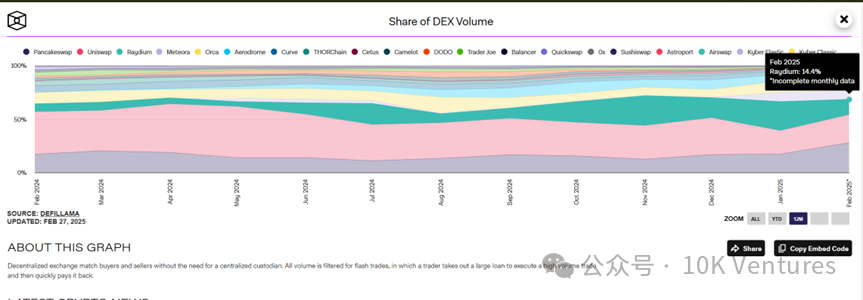
After the internal market of Pump.fun ends, meme coins will come to Raydium for trading. In January 2025, the index of DEX to CEX trading volume reached nearly 20%, breaking the previous ceiling of 15% we mentioned. According to our annual report, meme coins are actually competing for market share of mid-to-late stage VC coins. Especially after the Trump couple issued meme coins on Solana, the DEX market share on Solana further increased. In December 2024, the market share comparison of Raydium (Solana) vs Uni (Ethereum) was 19% vs 34%, but by January 20, Raydium's market share had equaled Uni's, both at 25%. In the recent week of Trump trading, Raydium's market share even temporarily exceeded Uni's.
Raydium charges 0.25% per transaction, of which 0.22% goes to LPs, and 0.03% is used to repurchase Ray. Ray has more utility compared to Uni. Due to regulatory issues, Uni only has governance functions, while Ray can also be used for transaction fee payments and IDO functions, with 12% of the fees generated from Raydium's transactions used to repurchase Ray.
From April 1 of last year to now, tokens launched from Pump.fun have contributed $346 billion in trading volume to Raydium, accounting for half of the total flow of that DEX, while the platform has collected $197 million in fees, of which $104 million surprisingly came from Pump.fun's transactions.

Now Pump.fun may be internally testing AMM, which means Raydium's uniqueness may no longer exist. In fact, we have always been puzzled as to why such a profitable business does not do it themselves, needing to share the most profitable profits with Raydium, which seems very unreasonable.
The token utility of JUP+JLP is very good, and it is recommended to keep an eye on it.
Jupiter is the largest perp DEX and spot aggregator on Solana. Jupiter's core business mainly includes: 1. DEX aggregation; 2. perp DEX; 3. DCA; 4. limit orders. Jupiter does not charge users any fees for spot aggregation trading, but charges a platform fee of 0.1% for Limit and DCA services. From the trading volume in the chart below, it can be seen that perp DEX trading volume is the main source of income. In perpetual contracts, Jupiter earns 0.06% of users' open positions AUM as a source of income, followed by liquidation fees. Additionally, Jupiter has launched the JLP pool, allowing users to inject liquidity into the pool to bet against retail investors. A portion of Jupiter's trading fees and retail liquidation fees is deposited into the JLP pool, thus continuously increasing the value of the JLP pool. The token utility of JUP is also continuously improving, with 50% of protocol fees currently used to repurchase JUP, providing a certain price guarantee for JUP.


JLP can be seen as betting against retail investors within contracts, earning fees and benefiting from users' profits/losses. According to the law of large numbers, a contract exchange that can still liquidate under a negative-sum game will definitely earn money over time. JLP decentralizes the model originally used by CEX contracts, allowing retail investors to add liquidity in the pool and bet against other retail investors trading contracts. As long as time is extended, it will definitely be profitable; after all, in a short time, LPs may also incur losses when encountering black swan events. JLP is actually a very good wealth management scenario. Excluding the asset appreciation of the assets in the pool (the annual appreciation of SOL, ETH, BTC), the pool's fees + funding rates + asset appreciation from users' net losses have also reached an annualized rate of 44.11%.
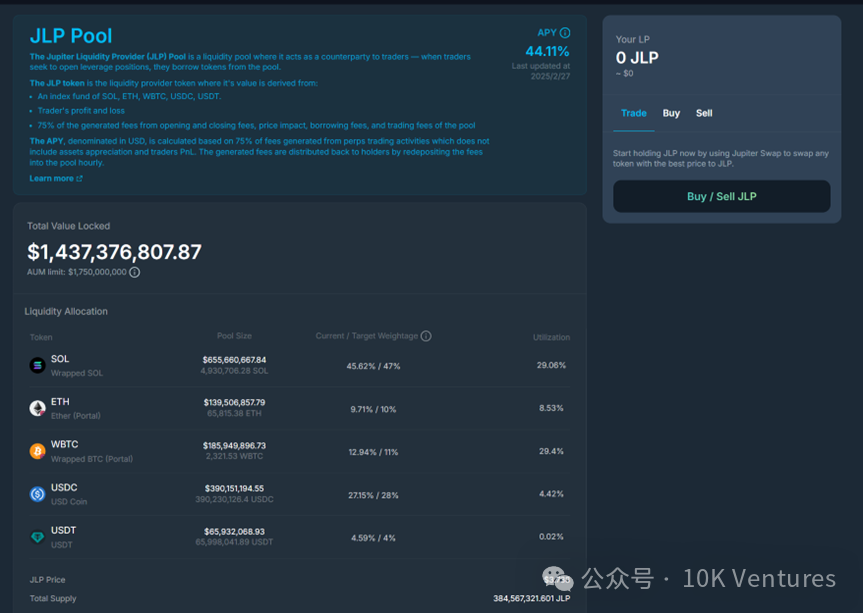

1.2 Can the collapse of Meme lead to a counterattack from VC coins?
Since the end of January 2025, BTC has been oscillating downwards from a high of $110,000, with a single-day drop of over 6% to $88,189 on February 26, putting pressure on SOL prices and causing Meme coins on the Solana chain (such as BONK, WIF) to drop over 30% in a single day.
The daily number of new tokens on pump.fun has decreased from 60,000 to less than 30,000, partly due to market fatigue with the "one-click token issuance" model. The proportion of new tokens successfully "graduating" (reaching liquidity thresholds) has dropped from 1.5% to 0.8%, reflecting an accelerated elimination of low-quality projects. After speculative funds withdrew, only a few projects could survive.


On January 18, the Trump family issued coins (TRUMP, MELANIA), sparking market frenzy and controversy. The opening price of TRUMP was $0.1824, and within 48 hours, it surged over 43,860% to $80, with celebrity endorsements becoming the core driving force behind the short-term surge of Meme coins.
On February 15, Argentine President Javier Milei publicly supported a Meme coin called $LIBRA on social media, claiming it aimed to support small businesses and economic development in Argentina, along with the token contract address. The token price skyrocketed to $4.96 within half an hour, with a market cap nearing $5 billion, but subsequently plummeted 85% to below $0.6 due to the team cashing out massively (about $107 million), resulting in significant losses for investors. This incident raised global concerns about "political Meme coins," with the market worried about celebrities abusing their influence to harvest retail investors in the absence of regulation.
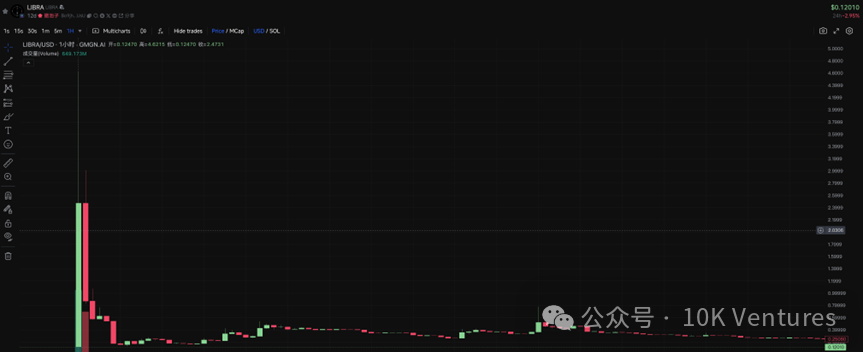
Several leading Meme tokens that once dominated the market have significantly retraced from their historical highs, with an average decline of over 80%.
AI16Z (AI Agent leader): Plummeted from $2.49 to $0.34 (-86%), mainly due to the decline in market interest in the AI Agent narrative.
AIXBT (crypto intelligence platform): Dropped from $1.06 to $0.21 (-80%), despite support from large whales, the sector's correction combined with shrinking liquidity has put pressure on prices.
SWARMS (decentralized AI network): Fell by 90% ($0.63 to $0.06), reflecting the market's abandonment of AI concept tokens lacking practical use cases.
Trump family coins (TRUMP, MELANIA): TRUMP dropped from $85 to $13 (-85%), while Melania coin plummeted 95% ($18 to $0.86), mainly due to regulatory concerns and the bubble bursting after traffic dispersed.

Tokens like AI Agent that were once hot have entered a "squat period," with most leading tokens relying on traffic hype and lacking technical support. Once community interest declines, they face the risk of collapse. This round of sharp declines confirms the characteristic of Meme coins being "volatile in both rises and falls," and investors need to be wary of "narrative tokens" with no substantive value. Take profits when available, play new rather than old, and have no faith; this is the essence of on-chain Meme coins.
One viewpoint is that since pump.fun became popular, there has been little innovation in new tracks in this industry. In the past two years, fewer founders have claimed to change the world with blockchain, and more founders have admitted that this track is just a big casino. Inventing a new track and issuing a new CA may ultimately yield the same result; both are about decorating a Christmas tree, just that the new track's Christmas tree will be smoother, while the CA's Christmas tree is about rapid rises and dumps. Three years ago, teams were inventing new tracks and telling new narratives. Now it’s different; now, you just need to issue a new CA.
But now the traffic and hype of pump.fun seem to have ended; could this provide a glimmer of opportunity for teams that are genuinely doing work? Let’s wait and see.
02 The New Chain War is Beginning
2.1 Berachain
Berachain is the public chain with the fastest TVL growth recently, with TVL rapidly increasing from an initial $500 million to $3.2 billion, thanks to its unique POL (proof of liquidity) consensus.
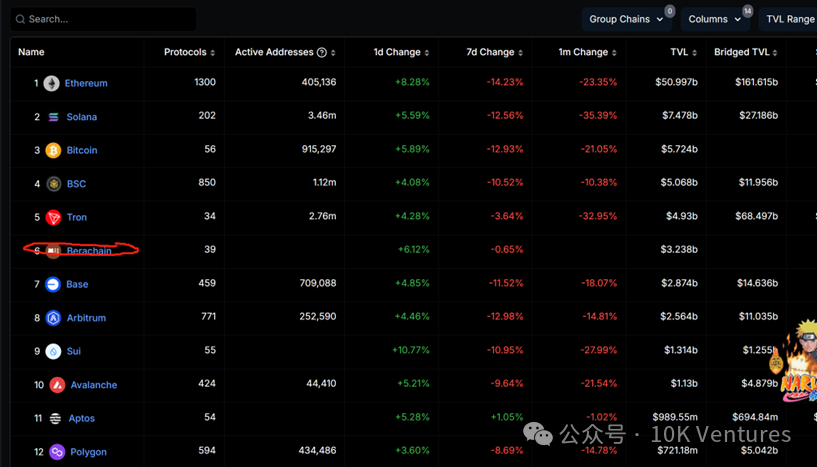
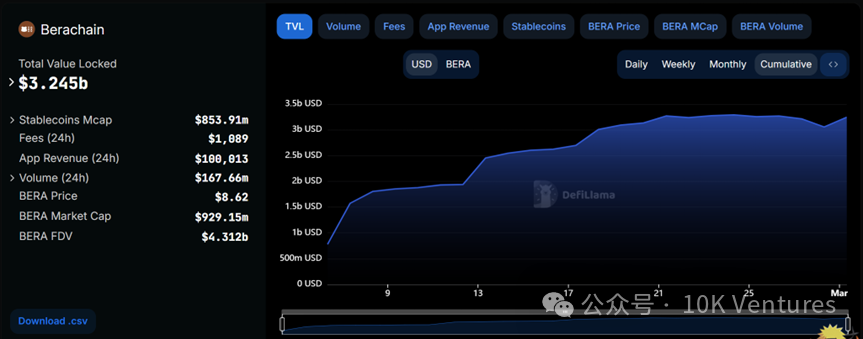
POL mainly involves three tokens:
Bera, the native gas token, gas fee token, and staking token.
BGT, the governance token, which is a one-way convertible SBT + reward token (Bera cannot be converted into BGT). Users participating in Berachain's DeFi earn BGT rewards, and then users can choose whether to convert it into Bera.
Honey, a stablecoin. Users can deposit collateral into the vault to mint Honey, and BGT holders govern the vault.
POL differs from POW/POS/POH, as it purely rewards contributions from DeFi liquidity providers, which will reward more users participating in the system. POL can bring very strong ecological growth in the early stages of a project. However, this is also a double-edged sword; the inflation rate of BGT in the first year is 10% of the total supply, which will bring 50 million BGT to the market. Considering that all BGT will circulate in the market, combined with the current circulation of 107 million Bera, this could bring nearly 50% additional circulation to the market. Since BGT is held by large DeFi participants (such as early teams and key partners), retail investors hold very few BGT, so large holders may bring potential severe sell pressure—this is not unfounded, as Berachain's co-founder DevBear sold tokens on a real-name address. He obtained about 200,000 BERA from the airdrop (which is itself unreasonable, as the airdrop rules were set by them), and then he exchanged some of the tokens for assets like WBTC, ETH, BYUSD, etc.
Therefore, we do not have an overly aggressive price prediction for Bera, but we are optimistic about the rapid growth that its POL brings to the ecosystem.
If Bera is later hyped by KOLs and large holders, it may again become a classic Christmas tree + see who runs fast scenario.
2.2 Sonic
Another public chain ecosystem worth paying attention to is Sonic. Sonic's TVL skyrocketed 8 times within a month, rising against the backdrop of a sluggish market. The APRs of major DeFi pools remain high, creating a dual cycle of token prices and APRs.

Sonic was once the public chain Fantom, which gained market attention during the last cycle due to DeFi projects like SpookySwap, Beefy Finance, and Scream brought by Andre Cronje. At the same time, Andre Cronje became the public chain IP and embodiment of influence for Fantom. With AC's return to Sonic, unlike four years ago, AC has brought new gameplay: x(3,3).
x(3,3) is vividly reflected in ShadowExchange, where users can stake SHADOW to obtain xSHADOW. However, the redemption share for users will change over time; if unlocked within 15 days, it requires a discounted exchange, and only after 60 days can it be fully exchanged at a 1:1 ratio, with the discount level decreasing linearly over time.

Since immediate withdrawal incurs a 50% loss, the lost portion of the earnings is shared among the remaining stakers. This model allows long-term stakers to receive: 100% of protocol fees, voting rewards, and remaining exit rewards. The x(3,3) model not only attracts long-term stakers' capital but also addresses the exit issues of ve(3,3).
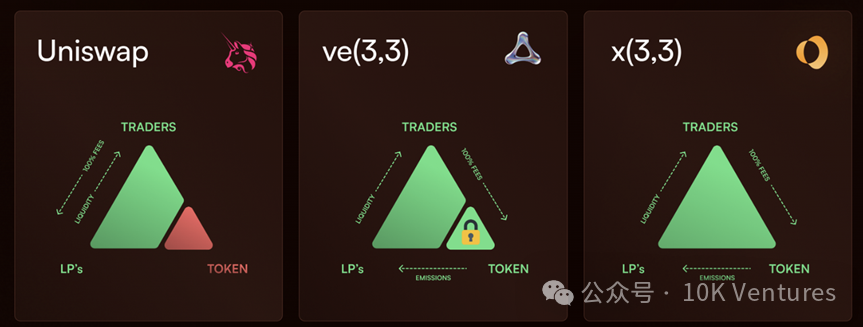
After DeFi led the capital backflow, Sonic also began meme marketing. Although AC himself has openly expressed his dislike for memes, he still held a meme contest. For example, community mascots GOGLZ, TinHatCat, and AC's cat have all seen explosive price increases alongside Sonic's prosperity. However, unlike the meme coins in the Solana and Base ecosystems, the memecoins in Sonic rely more on ecological subsidies and contest marketing, lacking widespread market consensus. We believe Sonic's meme is merely a short-term speculative target.
At the same time, NFTs in the Sonic ecosystem have also brought significant wealth effects. The core NFT in the Sonic ecosystem is Derp, which has strong consensus within the Sonic team. AC even changed his FateAdventure avatar to Derp. The floor price for Derp at 10K was 600S, and by February 28, it had skyrocketed to 2300S.

In addition, gaming is also a key focus area in the Sonic ecosystem. Representative projects include FateAdventure, Sacra, and EstforKingdom. Their related tokens $FA, $SACRA, and $BRUSH have all seen varying degrees of significant increases.
The Sonic public chain attracts TVL through DeFi and has a well-developed ecosystem application. The token S is a good β target, and after the market correction, its market cap has fallen to around 2.3 billion, still worth building a position. The α assets in the Sonic ecosystem include DeFi: Shadow, NFT: Derp, Meme: GOGLZ, and Game: FA.
2.3 Sahara
Sahara AI is an AI x crypto project we invested in during the first round in 2023. Sahara is building a platform where anyone can monetize AI models, datasets, and applications in a collaborative space. Users can manually train models without permissions, provide training data, and use no-code tools to create customized AI models.
Recently, Sahara has some interesting data to share regarding its business. In the past, we would charge whether the data quality generated from decentralized data labeling could meet the data needs of large models. From the data of Sahara Test season 1, we see that although the acceptance rate for advanced tasks is only 10%, they still generated over 24,000 high-value data points crucial for testing the safety and robustness of AI models. The low acceptance rate for these tasks indicates that planning high-quality, domain-specific datasets is challenging. These tasks require contributors to generate edge adversarial inputs aimed at testing the boundaries of LLMs. Overall, Sahara improves data quality through measures such as automatically checking and marking low-quality submissions, decentralized peer review, machine review of complex binary characters, and final Human QA review. Sahara will launch Test Season 2 to continue expanding data labeling content.
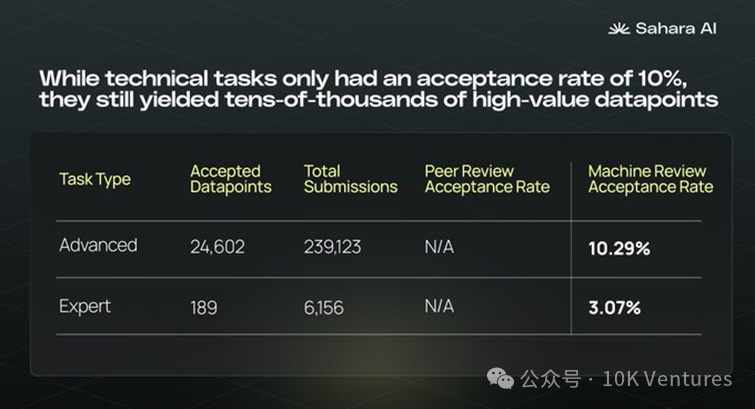
In addition, Sahara has launched the Sahara Incubator Program. This program aims to discover and support the most promising AI x Web3 innovative projects globally, providing selected teams with comprehensive resource support, including in-depth technical guidance, ecosystem integration, and financing acceleration services, to assist the long-term development of AI-native projects. As a pioneer in the intersection of Web3 and AI, Sahara AI is committed to building a collaborative economy AI blockchain platform, focusing long-term on the R&D of AI infrastructure and intelligent applications, and promoting decentralized innovation in AI through blockchain technology.
The incubator program will focus on two major tracks: AI infra and AI application, welcoming teams with MVP or higher maturity to participate. Successfully selected projects will have the opportunity to fully integrate into the Sahara AI ecosystem, receive exclusive technical support, market expansion resources, and investment opportunities, helping teams connect with investment networks to jointly create the next generation of AI x Web3 products.
03 Subsequent Guidance for the Primary Market
The only consensus at the Hong Kong Consensus Conference is the need to invest in projects with business models. The most distinct feature of this cycle compared to previous ones is that projects have emerged, and aside from selling tokens, stable business models are currently related to trading (cex/dex, lending, perp, brokerage, wallets), asset management (earning volatility), stablecoins (trading chips + cross-border payments), and new public chains (new casinos, also trading-related) are evergreen in blockchain. These tracks have shown strong revenue growth in 2024. We will not elaborate on the revenue situations of new players like Pump.fun/Ethena, but non-giant startups like Solv (Bitcoin asset management), Particle (dex), and Moonshot (brokerage) have also achieved over $10 million in revenue in a year by starting in new directions, beginning to prove the revenue capabilities of companies in the crypto space.
As the business competition cycle in the "crypto circle" lengthens, the requirements for entrepreneurs will also increase. Now, having vision alone is not enough; leadership is also required to continuously make the right decisions over a long period and to build efficient organizations.
Returning to "People game, people first," amplifying the weight of "people," focusing on three things: whether making the right decision at a critical moment is a result of luck or thought, whether one can build efficient organizations, and the resilience to rise from the trough.
Make counterintuitive decisions, find excellent founders who are counterintuitive, and stay away from projects that are just gathering momentum; the cycle's fluctuations can be fatal for unstable team organizations.
Prioritize product experience, then think about which tracks and products will be needed in the blockchain industry five years from now.
免责声明:本文章仅代表作者个人观点,不代表本平台的立场和观点。本文章仅供信息分享,不构成对任何人的任何投资建议。用户与作者之间的任何争议,与本平台无关。如网页中刊载的文章或图片涉及侵权,请提供相关的权利证明和身份证明发送邮件到support@aicoin.com,本平台相关工作人员将会进行核查。





